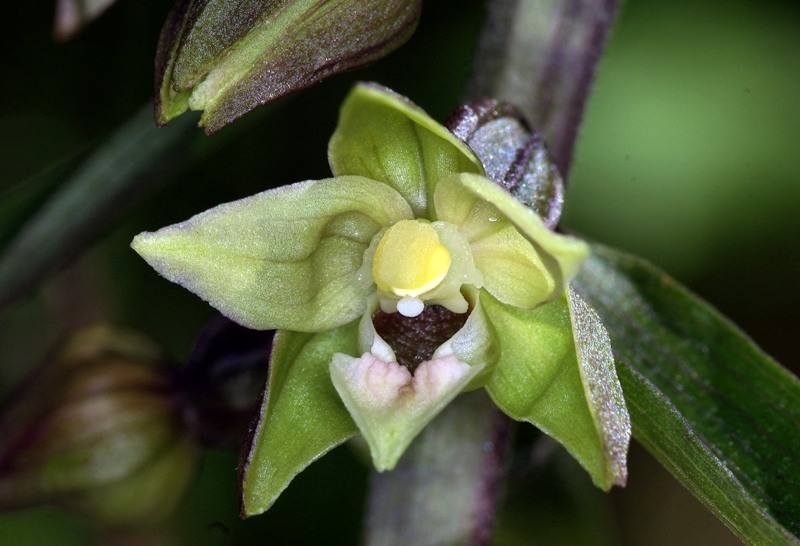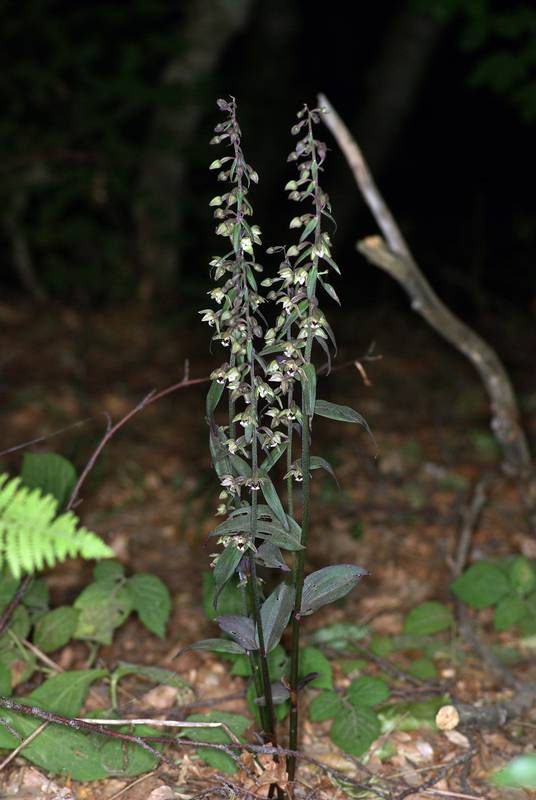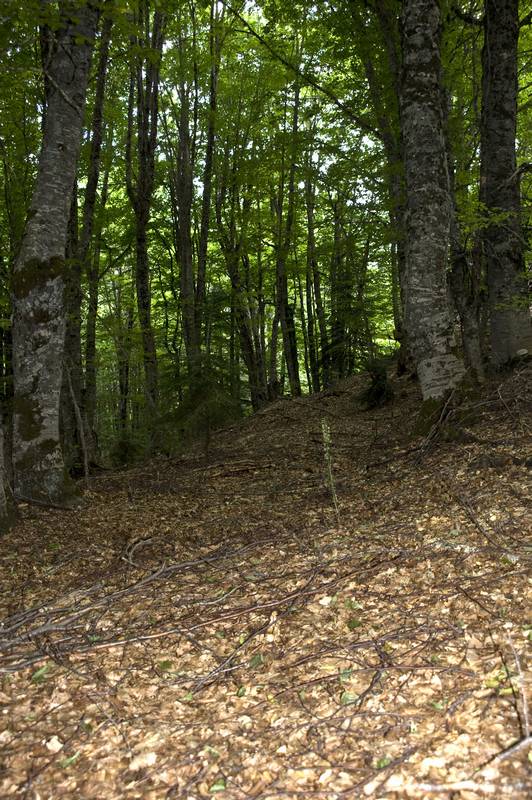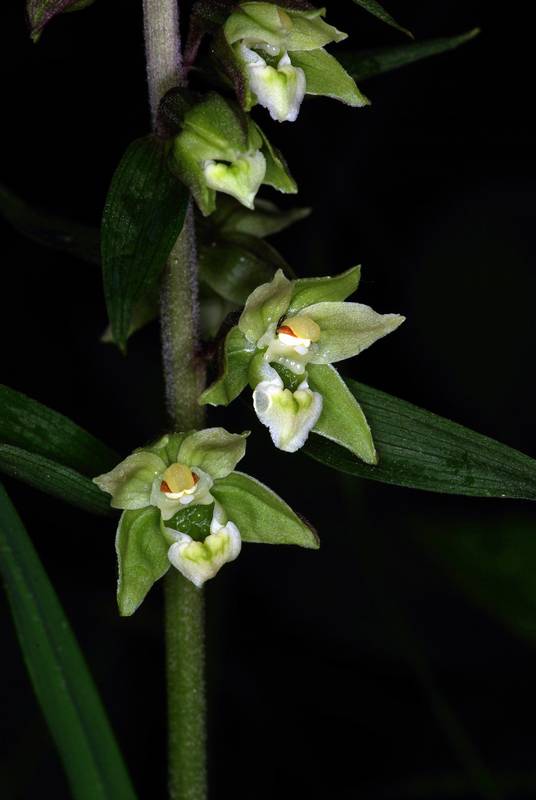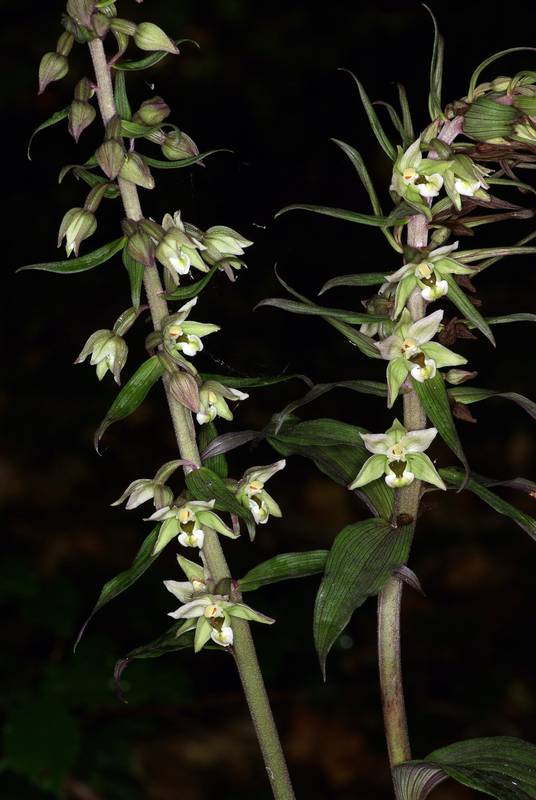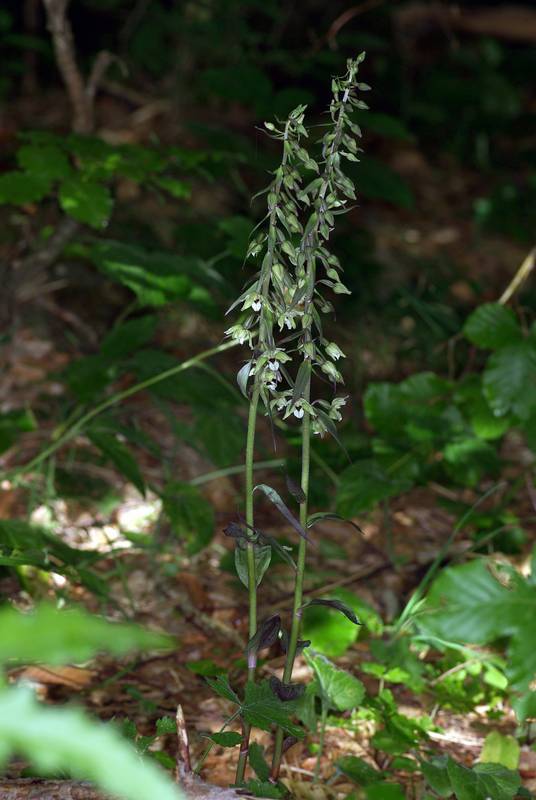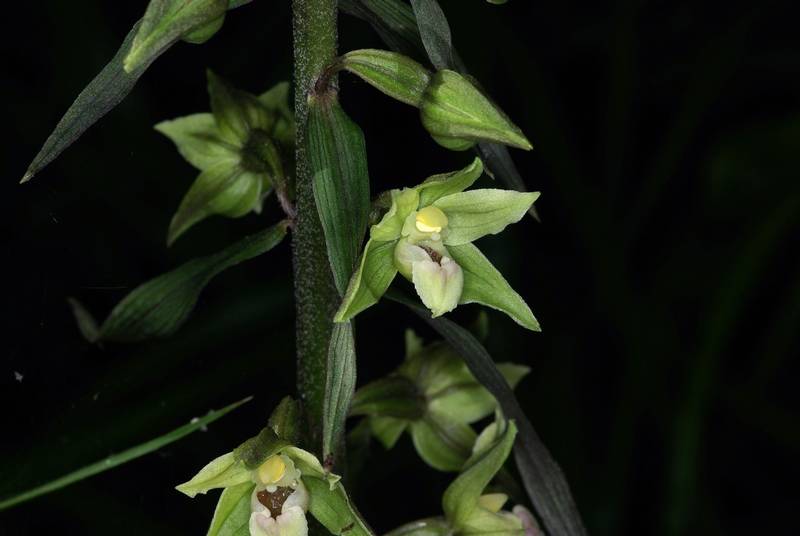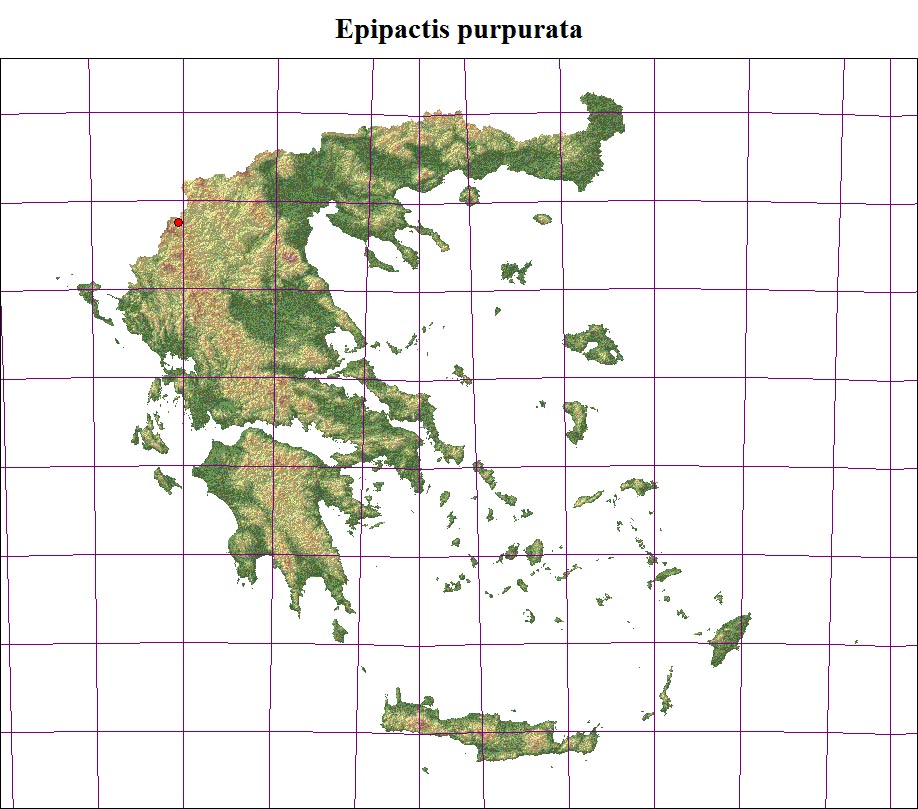Epipactis purpurataJ.E. Smith, 1828 |
||||||
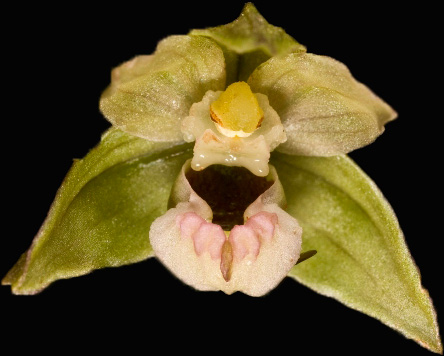 |
||||||
|
Κατανομή: Η E. purpurata παρουσιάζει ευρεία κατανομή κυρίως στην εύκρατη κεντρική και δυτική Ευρώπη. Η κατανομή της επεκτείνεται προς νότο κυρίως στην Ιταλική χερσόνησο, ανατολικά στην Κριμαία και δυτικά στα Πυρηναία, ενώ η εξάπλωσή της στα Βαλκάνια περιορίζεται κυρίως στα βόρεια (Ρουμανία, Ουγγαρία και ελάχιστες θέσεις σε Κροατία, Σερβία και Βουλγαρία). Περιγραφή: Πολυετές φυτό, με ύψος 20-50 (-70) cm. Τα φυτά έχουν την χαρακτηριστική τάση να σχηματίζουν μπουκέτα αποτελούμενα από πολλούς βλαστούς, συνήθως 3-8. Ο βλαστός είναι παχύς με πράσινο ή και συχνά ιώδη χρωματισμό, καλυμμένος με κοντές τρίχες και τα βασικά φύλλα είναι σχετικά μεγάλα, χαρακτηριστικά βιολετί και σπειροειδώς διατασσόμενα πάνω στον βλαστό. Η ταξιανθία είναι πυκνή με πολλά άνθη (25-50) και αρκετές φορές μονόπλευρη. Τα βράκτια είναι οξύληκτα και τα κατώτερα ως και 2 φορές μεγαλύτερα από τα άνθη. Η ωοθήκη είναι πρασινωπή – ιώδης με μικρές τρίχες. Τα σέπαλα και πέταλα είναι από μέσα πρασινωπά και από έξω μερικές φορές ιώδη. Το υποχείλιο είναι ευρύ, με υπόλευκο χρωματισμό και η ένωσή του με το επιχείλιο είναι αρκετά φαρδιά. Το επιχείλιο είναι καρδιόσχημο, κυρτό προς τα κάτω με δύο αρκετά τονισμένα εξογκώματα στη βάση τα οποία έχουν ρηχότερες αυλακώσεις. Βιότοπος: Η Ε. purpurata προτιμά σκιερά μέρη με μέτρια υγρασία, πάνω σε νωπά, πλούσια σε ασβέστιο, εδάφη. Συνήθως φυτρώνει στην σκιά πλατύφυλλων δασών, σε οξιές και σπανιότερα βελανιδιές και ακόμα σπανιότερα σε κωνοφόρα δάση. Στην Ευρώπη φύεται από χαμηλά υψόμετρα μέχρι τα 1.500μ. Είναι αλλόγαμη ορχιδέα δηλαδή προσελκύει έντομα επικονιαστές κυρίως διάφορα είδη σφηκών. Μερικά φυτά, ιδίως αυτά που αναπτύσσονται σε πολύ σκιερά μέρη, περιέχουν στις ρίζες τους συμβιωτικούς μύκητες (mycorrhizal fungi) και πολύ σποραδικά άτομα δεν διαθέτουν χλωροφύλλη και εμφανίζουν εντελώς ρόδινη απόχρωση στα φύλλα και βλαστό (var. rosea). E. purpurata στην Ελλάδα: Οι αναφορές για την Ελλάδα είναι ελάχιστες, παλιές, μη τεκμηριωμένες και πιθανά αφορούν λανθασμένες αναγνωρίσεις E. subclausa ή E. halascyi, ειδών με εξάπλωση στην Πίνδο και Πελοπόννησο που μοιάζουν με την E. purpurata ιδίως σε φάσεις πριν την ανθοφορία, λόγω τους ιώδους βλαστού τους. Έτσι ενώ οι Baumann και συν. (2006) περιλαμβάνουν και την Ελλάδα στον οδηγό τους, ο Delforge (2006) δεν την περιλαμβάνει στις χώρες που το είδος αυτό κατανέμεται. Το 1992, σχεδόν 20 χρόνια πριν, ο Dr. Horst Kretzschmar, κατά την διάρκεια εξόρμησης στη βόρεια Πίνδο, ανακάλυψε πληθυσμό 200 φυτών σε μια μεμονωμένη θέση του Γράμμου, κοντά στα Ελληνοαλβανικά σύνορα. Τα φυτά ταυτοποιήθηκαν από τον ίδιο ως E. purpurata χωρίς να παραθέσει φωτογραφικό υλικό, ή να δημοσιεύσει ποτέ την ανακάλυψη. Στα τέλη Ιουλίου του 2010, περίπου στο σημείο που υπέδειξε ο Kretzschmar, βρέθηκαν ξανά περί τα 50 φυτά, στην πλειονότητά τους πριν την άνθηση, επιβεβαιώνοντας την ύπαρξη και σταθερότητα, στην διάρκεια των 20 ετών, της εν λόγω αποικίας στη μοναδική αυτή θέση εντός της ελληνικής επικράτειας. Ακολούθησαν ακόμα 2 ταξίδια με σκοπό την καλύτερη μελέτη και καταγραφή στις 1 Αυγούστου 2010 και 31 Ιουλίου 2011. Στις δύο επισκέψεις του 2010 διαπιστώθηκε ότι τα περισσότερα φυτά αναπτυσσόταν σε βόρειας έκθεσης πλαγιά στα 1.300 μέτρα με μικτό δάσος μαύρης πεύκης (Pinus nigra) και οξιάς (Fagus sylvatica). Παραδόξως, πολλά άτομα βρέθηκαν στον υποόροφο πεύκων, ανάμεσα σε φτέρες και σε σερπεντινικό υπόστρωμα, σε αντίθεση με τα συνήθη ενδιαιτήματα της E. purpurata στην κεντρική Ευρώπη (οξιά). Στις εξορμήσεις αυτές το 90% των φυτών δεν διέθετε ακόμα ανοιχτά άνθη, γεγονός που οριοθετεί την εποχή άνθησης των ελληνικών E.purpurata στο πρώτο 15θημερο του Αυγούστου. Κατά τη διάρκεια της τελευταίας επίσκεψης του 2011, πέντε ακόμα θέσεις ανακαλύφθηκαν με υψομετρική διακύμανση μεταξύ 1.200-1.460, δύο εξ αυτών σε μικτό δάσος Pinus nigra, Abies x borisii-regis (υβριδογενής ελάτη) και Fagus sylvatica και τρεις σε σκιερά δάση οξιάς (Fagus sylvatica). Επίσης, ανακαλύφθηκαν τουλάχιστον 4 υβρίδια Ε. helleborine x E. purpurata. Η περαιτέρω ανακάλυψη ακόμα 5 θέσεων στην ευρύτερη περιοχή αποδεικνύει ότι η ύπαρξη της Ε. purpurata είναι καλά εδραιωμένη, τουλάχιστον στις πλαγιές των ορεινών όγκων βορειοανατολικά της κορυφής του Γράμμου. Τα φυτά του Γράμμου σχηματίζουν συμπλέγματα με 2 ως 5 και σπανιότερα ως 8 βλαστούς, παρατήρηση συμβατή με άλλες περιοχές της Ευρώπης, χωρίς τα μεμονωμένα άτομα να είναι σπάνια. Στις θέσεις του Γράμμου που παρατηρήθηκαν E. purpurata βρέθηκαν επίσης E. helleborine, Ε. exilis, Ε. microphylla, Dactylorhiza saccifera και Epipogium aphyllum. Εποχή άνθησης: Ο χρόνος άνθησης στην κεντρική Ευρώπη κυμαίνεται από τα μέσα-τέλη Ιουλίου μέχρι τα μέσα Σεπτεμβρίου, συνήθως λίγο αργότερα από τις συντοπικές E. helleborine. Στην Ελλάδα φαίνεται ότι η εποχή άνθησης καλύπτει το πρώτο δεκαπενθήμερο του Αυγούστου. Distribution: E. purpurata in
Greece: |
|
|||||
|
|
||||||
|
|
||||||
|
|
||||||
|
|
||||||
|
|
||||||
